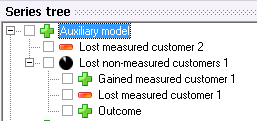
Depending on changes to the customer data, the need may arise to adjust the history to be able to obtain optimum forecast data. When new customers are added to the forecast series, the history of these customers should also be added to the history, if available. By the same token, consumption that has disappeared should be deleted from the history. This can be dealt with in Aiolos in a number of ways. One way is to make the changes using the tree structure shown below. The series type for the series that is to be forecast must be changed from “forecast series” to “Aggregated forecast series”. This indicates that the forecast data is to be aggregated and not read from a load file. The original series that represents the true result (outcome) for the customer data in question at each time must be at the very bottom of the tree structure at “sheet” level. All changes must then be ordered chronologically from the bottom upwards so that “Lost customer 1” is the first change that occurs in the series. Four cases are possible:
•Added customers with known history: Should be imported into Aiolos as a series up to the time when the consumption is included in the result series “Outcome”. This series must be added to the result series.
•Lost customers with known history: As above, but this should instead be subtracted from the result series.
•Added customers with unknown history: These customers can be estimated as a percentage increase in the result series. In this case, the history can be aggregated with a proportion of over 100% before the time of the increase and a proportion of 100% after the results of these customers have been included in the result series “Outcome”.
•Lost customers with unknown history: As above, but the proportion should then be set to less than 100% before the change (shown in the image below).

The result of the aggregation is called a reference and is used as input data to the forecast process. For evaluations, however, the original result (outcome) must be used instead, at least when a comparison is being made with saved historical forecasts. This is done if in the configuration you designate the load file for the result in the settings for the reference series. If the tree structure has grown too big, it can at any time be replaced entirely with a new reference series where only the values of the aggregation are saved. In the above example, all series from “Lost measured customer 2” to “Outcome” would be replaced by a “Reference” series. If you prefer to calculate the reference values externally outside Aiolos, these can be imported into Aiolos and saved together with the result in a load file with the file suffix “.aio5”.